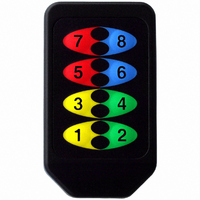OTX-433-HH-CP8-MS Linx Technologies Inc, OTX-433-HH-CP8-MS Datasheet - Page 2

OTX-433-HH-CP8-MS
Manufacturer Part Number
OTX-433-HH-CP8-MS
Description
TRANSMITTER 433MHZ MS SERIES
Manufacturer
Linx Technologies Inc
Datasheet
1.OTX-433-HH-CP8-MS.pdf
(5 pages)
Specifications of OTX-433-HH-CP8-MS
Function
Transmitter
Modulation Or Protocol
ASK, OOK
Frequency
433MHz
Applications
General Remote Control, Garage Opener, RKE
Interface
Handheld, 8 Button
Data Rate - Maximum
9.6 kbps
Features
8 Buttons, 1000 ft. Operating Distance
Voltage - Supply
2.1 V ~ 3.6 V
Package / Case
Handheld Transmitter
Board Size
71.4 mm x 41.1 mm x 15.2 mm
Minimum Operating Temperature
- 40 C
Supply Voltage (min)
2.1 V
Product
RF Modules
Maximum Frequency
433.92 MHz
Supply Voltage (max)
3.6 V
Supply Current
3.4 mA
Maximum Operating Temperature
+ 85 C
Lead Free Status / RoHS Status
Lead free / RoHS Compliant
Power - Output
-
Sensitivity
-
Lead Free Status / Rohs Status
Lead free / RoHS Compliant
Available stocks
Company
Part Number
Manufacturer
Quantity
Price
Company:
Part Number:
OTX-433-HH-CP8-MS
Manufacturer:
LNX
Quantity:
30
Notes
1. Characterized, but not tested
THEORY OF OPERATION
Page 2
ELECTRICAL SPECIFICATIONS
Parameter
POWER SUPPLY
Operating Voltage
Supply Current
Power-Down Current
TRANSMITTER SECTION
Transmit Frequency Range:
Center Frequency Accuracy
ENVIRONMENTAL
Operating Temperature Range
OTX-315-HH-CP8-MS
OTX-418-HH-CP8-MS
OTX-433-HH-CP8-MS
The OTX-***-HH-CP8-MS Compact Handheld Transmitter combines an LR
Series transmitter and an antenna with an on-board MS Series encoder to form
a simple, yet highly reliable RF remote-control transmitter. The LR Series
transmitter is a low-cost, high-performance synthesized ASK / OOK transmitter.
The transmitter’s synthesized architecture delivers outstanding stability and
frequency accuracy, while minimizing the effects of antenna port loading and
mismatching. This reduces or eliminates frequency pulling, bit contraction, and
other negative effects that are common to SAW-based transmitter architectures,
providing a significantly higher level of performance and reliability.
When a button is pressed on the transmitter, power is applied to the internal
circuitry and the encoder is enabled. The encoder then detects the logic states
of the button data lines. These states are formatted into a 2-word transmission
cycle which continues until the button is released. The encoder data is used to
modulate the transmitter which conveys the data into free space through the
antenna. Once data is received, a decoder IC is used to check the transmitter’s
address against an address saved in memory. If a match is confirmed, the
decoder’s outputs are set to replicate the transmitter’s button states. These
outputs can then be used to activate external circuitry required by the
application.
The transmitter is compatible with the LT and LR product families. For
applications where range is critical, the LR Series receiver is the best choice due
to its outstanding sensitivity. When the transmitter is combined with an LR Series
receiver and an MS Series decoder, ranges of up to 750 feet are possible.
Applications operating over shorter distances will also benefit from the increased
link reliability and superior noise immunity provided by the LR Series receiver.
Designation
V
I
I
PDN
F
CC
–
–
CC
C
Min.
2.1
-50
-40
–
–
–
–
–
Typical
433.92
315
418
3.0
3.4
5.0
–
–
Max.
+50
+85
3.6
–
–
–
–
–
Units
VDC
MHz
MHz
MHz
kHz
mA
nA
°C
Notes
–
–
1
–
–
–
–
1
SETTING THE TRANSMITTER ADDRESS
OTX-***-HH-CP8-MS BUTTON ASSIGNMENTS
Figure 3: OTX-***-HH-CP8-MS Button Assignments
The MS Compact Handheld Transmitter
allows
16,777,216 (2
transmitters are supplied set to the
same address. To avoid contention with
other
relationships, the address can be
changed. This is accomplished by using
a paper clip or probe to press the
CREATE button on the board through
the hole in the back of the case. Press
the button and a LED will light up in the
MODE_IND window, indicating that the
address is being created. The address will be randomized for as long as the
button is held down. Release the button and the randomized address will be
saved and the LED will begin flashing to indicate that the Control Permissions
may now be set. Press the buttons that the transmitter will have the authority to
access. Press the CREATE button with the paper clip again or wait 17 seconds
for it to time out. The address and Control Permissions are now set. The decoder
will need to learn the address before it will accept any transmissions. Please see
the Typical Applications section of this data guide or the MS Series Decoder
Data Guide for details.
This diagram illustrates the relationship between the button locations and
encoder data lines.
units
the
24
selection
or
) unique addresses. All
to
create
of
D6
D4
D2
D0
one
unique
of
Figure 2: CREATE Button Access
MODE_IND Window
D7
D5
D3
D1
CREATE Button
Page 3


















